The next-gen MacBook Pro with Retina Display Review
by Anand Lal Shimpi on June 23, 2012 4:14 AM EST- Posted in
- Mac
- Apple
- MacBook Pro
- Laptops
- Notebooks
All Flash Storage
As expected, the next-gen MacBook Pro ditches mechanical storage in favor of a MacBook Air style NAND + SSD controller on a custom PCB. Apple refers to this solution as all-flash storage.
Apple’s distinction between Solid State Drives (SSDs) and all-flash storage boils down to what form the storage comes in. If it’s a standard form factor device in a chassis, it’s a solid state drive. If it’s just NAND + controller on a PCB? Then it’s all-flash storage. I suspect it’s a nicer way of saying proprietary SSD but either way they are technically the same thing, just in different forms.
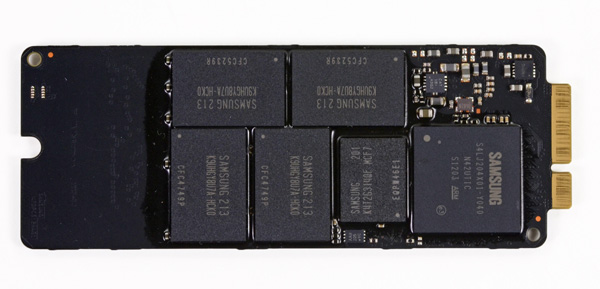
The Samsung PM830 based rMBP NAND flash storage card, image courtesy iFixit
My Retina MacBook Pro was the upgraded model with a 512GB SSD, featuring Samsung’s PM830 controller. This is the same controller as in the Samsung SSD 830, which I’ve long felt was the best pair for Mac users who wanted an SSD upgrade. I’m not sure if other Retina MBPs may come with Toshiba’s SandForce based drive instead. I have one of these drives in house for a review but that’ll have to wait until next week.
Although both the Samsung and Toshiba/SandForce controllers support full disk encryption, neither hardware based encryption is supported by OS X’s FileVault 2. When OS X encrypts your boot volume not all areas are encrypted (such as the recovery partition). While I know SandForce allegedly offers multiple encryption levels across a volume I’ve never seen either controller claim support for partially unencrypted volumes. In this case it looks like for Apple to take advantage of SSD controller based encryption it would need more flexible encryption support on the controller level. If I were an SSD controller vendor I’d be paying close attention to this requirement.
Both the Samsung and Toshiba controllers support 6Gbps SATA - as a result performance is significantly better compared to previous Apple branded SSDs. I borrowed a friend’s 2010 MacBook Pro which happened to have a Toshiba based SSD installed and ran it through our standard Iometer four-corners test suite. This was a well used drive and thus the performance is even worse than last year's MacBook Airs. The improvement in performance is astounding:
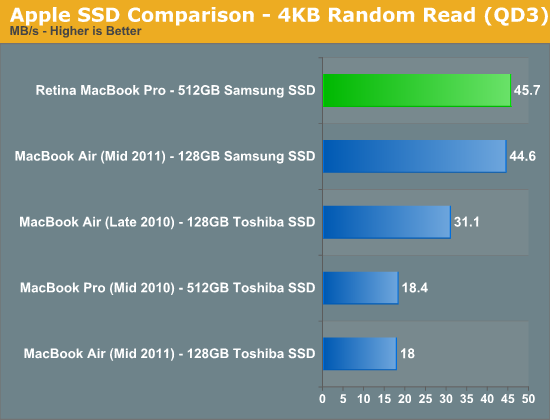
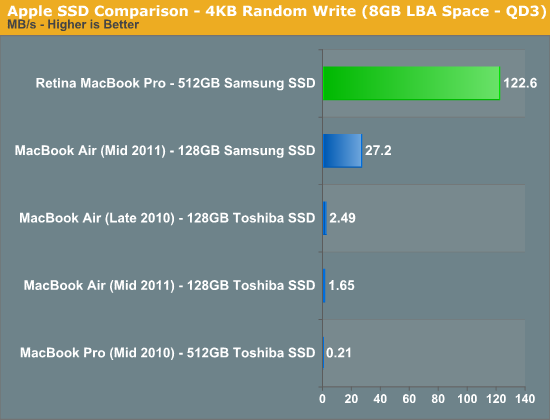
The move to 6Gbps SATA is often associated with a huge bump in sequential transfer rates, but in this case Apple enjoys a significant increase in random speeds as well. Note that some of this improvement is going to be due to the fully populated configuration of the PM830 in the Retina MacBook Pro's SSD, but that shouldn't downplay the significance of the move to Samsung's latest controller. The previous generation controller used last year just wasn't very good, and the Toshiba alternative was even worse. This year, Apple finally has a good solid state story to tell.
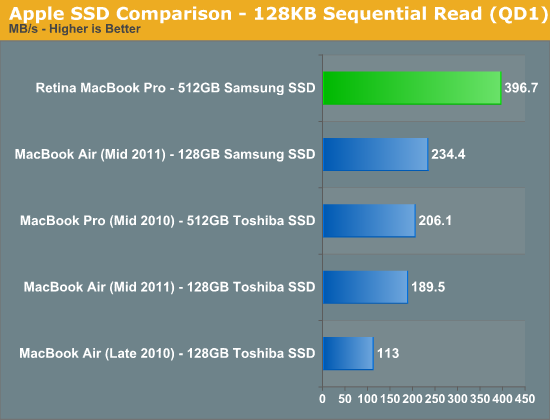
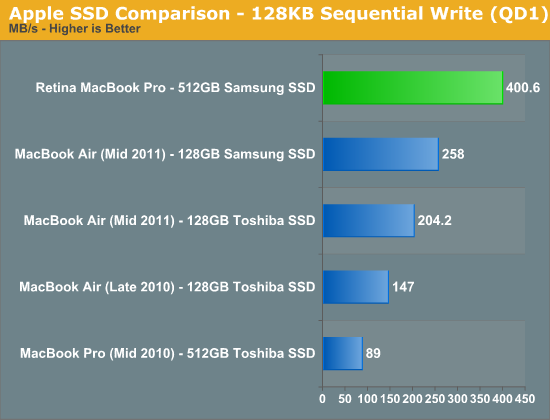
How much of this are you going to be able to actually tell in day to day use of the system? The sequential transfer rates are most tangible when you are writing to or reading large files like movies to your drive. Obviously you need a source that's fast enough to hit these speeds. Although USB 3.0 can come close you're unlikely to have a USB 3.0 SSD that's as fast as the internal drive. Moving large files between your internal SSD and Promise's Pegasus R4/R6 is where you'll really appreciate this performance.
The random access improvements are likely overkill for most normal uses. Things like program launches, compiling, web browsing, and any other normal application IO will depend on a mixture of random and sequential IO. The key is to have good enough random IO performance to avoid becoming a bottleneck. I can safely say that the numbers we see here are more than enough.
While previous Apple SSDs were nice only from a convenience standpoint, at least the Samsung option in the Retina MacBook Pro is what I’d recommend even if Apple didn’t bundle it with the machine.










471 Comments
View All Comments
EnzoFX - Saturday, June 23, 2012 - link
Just let apple push down the high end tech, let it trickle, and let pc manufacturers bring up their game, is it not a win win? Haters gonna hate, so lost.MacTheSpoon - Saturday, June 23, 2012 - link
I have to say, after having tried one out in an Apple Store, that I was pretty surprised how underwhelming and minor the screen improvement was. I would have thought from all the breathless press coverage that it was going to be a life-changer like apparently it was for Anand, but the fact was that looking at the thing at waist-height on its bench I personally couldn't even tell the difference. I had to stick my nose in it to see a difference. From a normal typing distance I could see a bit more of a difference, but not as much as I'd imagined.Maybe it's just that I have crappy eyes, but I didn't see a single other customer in the store looking at the displayed laptops, either. I bet most walked by without even noticing the different display--because laptops are already pretty close to a retina display at normal usage distances. It's not like a phone, where you hold the thing up to your face.
I also found it disappointing that 1080p stuff looked so small. You had to blow it up to full screen, and then it seemed...well, it didn't seem that sharp. It was pretty underwhelming. My test material was the Big Buck Bunny vid on YouTube. I thought, so I would pay all this money and end up with this subpar viewing experience?
Honestly I think I would probably prefer a great 1080p display with a full sRGB gamut. I like the black levels and contrast on the MBP, but you can pretty much get that and more on other laptops. And matte, too.
The thing that I liked most about the machine, when all was said and done, was its looks. I love the thinness. And the lack of the wedge shape, which never appealed to me. But I left the store feeling like I wasn't missing out on anything too amazing by not having that screen. For a pro machine I'd probably want a workstation with full gamut and as much storage as possible. For a multimedia machine I'd probably wait to see how the XPS 15 redesign turned out. It will probably offer better speakers, storage, and color for less than half the price.
Ohhmaagawd - Saturday, June 23, 2012 - link
I had exact opposite reaction. I went to the Apple store yesterday and was blown away by the screen.But you can't use youtube for your testing, they are all fuzzy.
Spoony - Saturday, June 23, 2012 - link
Sublime review, as we always relish from Anandtech.To follow up, what do we know about the thermal performance of Kepler and IVB in the 2011-style MBP chassis?
Additionally, does opting for the 2.3GHz model do any significant favors for temperature or battery life?
Reading this review on a Retina iPad was amusing because all the pictures were fuzzy. The web has a way to go before it looks great at 220+ dpi.
da1bigkahuna - Saturday, June 23, 2012 - link
I was wondering if you had any fairly broad comparisons you could make that we might expect from Haswell - and it's successor. I mean something like, "Haswell should be at least 10% faster overall, but the next chip will increase speed far more". Any info would be appreciated, but ultimately speed is the main thing. Next main thing would be if thunderbolt will be a lot better in those future systems.dagamer34 - Saturday, June 23, 2012 - link
I believe Haswell is another tock in terms of GPU design, and all CPUs are designed for far lower thermal limits. Anand has referred to it as the "ideal" ultrabook CPU, allowing for it to even be in the screen of a computer with a minor increase in thickness.houkouonchi - Saturday, June 23, 2012 - link
The reason I bought my first Mac. Of course I run at the native 2880x1800 (I ditch the HiDPI).The big problem I have had so far is getting it working in linux. Seems like really bad linux support right now. The nvidia driver doesn't want to work and the thunderbolt ethernet also doesn't work. The wireless is also really shoddy which made it a pain in the but to just get my linux installation moved over (probably easier if I installed off a USB cd-rom drive).
I am coming from a 22.2 inch 3840x2400 (204PPI monitor) so going to a 220 PPI laptop at native resolution was no big stretch for me. On linux I run X at 75 DPI even on those dense monitors. Its all about the desktop real-estate for me.
houkouonchi - Saturday, June 23, 2012 - link
Just to add its funny that running at the native 2880x1800 is the only way to have third-party apps look good (like word processors/excel/pdf that you can up the font/text size on). Also using safari + google maps the plugin was rendered at 1/4th the resolution. Rendered correctly when running native 2880x1800.krazyfrog - Saturday, June 23, 2012 - link
I would like you guys to add a webcam test as it will help judge the quality of the built-in webcam and microphones. Otherwise, a fantastic review, as usual.LuckyKnight - Saturday, June 23, 2012 - link
I hope Apple release a 13" Macbook Pro with dedicated graphics and a slightly better screen!!